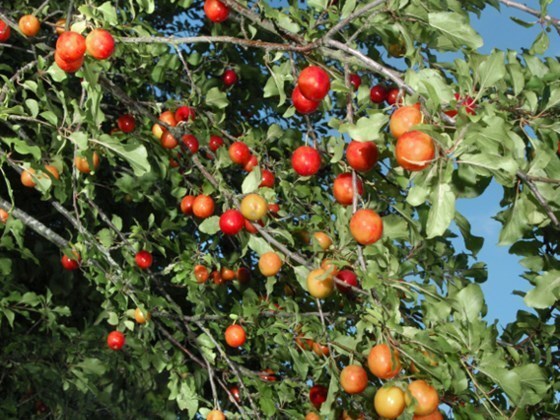WS #4: Cherry Plum Grove

The cache, a small black-taped screw-capped plastic pot, is hidden just off the riverside trail at the rear edge of a patch of this lovely large shrub/small tree which was in spectacular full flower when the cache was placed.
To reach the cache location: (from the west) park @ or near N 53 54.957 W 1 44.698 on the approach road to the old mill complex and after securing your car, cross the road and pick up the small trail heading across the top of the woodland, down to and along the river.
(from the east) park @ or near N 53 54.578 W 1 43.635 in the lay-by and pass through the gate at its west end into the field and across to the trail running alongside the river.
The cherry (or myrobalan) plum (Prunus cerasifera) is a plum species native to Southeast Europe and Western Asia, and naturalised in Britain and scattered locations in North America.
 It was originally brought to Britain for its fruit and as a grafting stock for cultivating more engaging domestic plums. It is more common in the south of England and usually appears in old gardens rather than in scrub woodland (where sloe will be found). When seen in a garden or hedge it will obviously have been planted there - it has been widely introduced into hedges and as an ornamental tree.
It was originally brought to Britain for its fruit and as a grafting stock for cultivating more engaging domestic plums. It is more common in the south of England and usually appears in old gardens rather than in scrub woodland (where sloe will be found). When seen in a garden or hedge it will obviously have been planted there - it has been widely introduced into hedges and as an ornamental tree.
Wild types are large shrubs or small trees reaching 8–12 m tall. It is one of the first European trees to flower in spring, often starting in mid-February before the leaves have opened.
The flowers are pure white or pale pink and about 2 cm across, with five petals and many stamens. The fruit is an edible drupe, 2–3 cm in diameter, ripening to yellow or red from early July to mid-September. They are self-fertile but can also be pollinated by other Prunus varieties such as the Victoria plum.
It plant propagates by seed or by suckering, and is often used as the rootstock for other Prunus species and cultivars.
It is a popular ornamental tree for garden and landscaping use, grown for its very early flowering. Numerous  cultivars have been developed, many for purple foliage. These forms (often called 'purple-leaf plum'), also have dark purple fruit, which make an attractive, intensely coloured jam. Some kinds of purple-leaf plums are used for bonsai and other forms of living sculpture.
cultivars have been developed, many for purple foliage. These forms (often called 'purple-leaf plum'), also have dark purple fruit, which make an attractive, intensely coloured jam. Some kinds of purple-leaf plums are used for bonsai and other forms of living sculpture.
Cultivated cherry plums can have fruits, foliage, and flowers in any of several colours. Some varieties have sweet fruits that can be eaten fresh, while others are sour and better for making jam. Cherry plums are a key ingredient in Georgian cuisine where they are used to produce tkemali sauce, as well as a number of popular dishes, such as kharcho (spicy beef soup) and chakapuli (lamb stew).
See here for several old botanical illustrations of this plant.